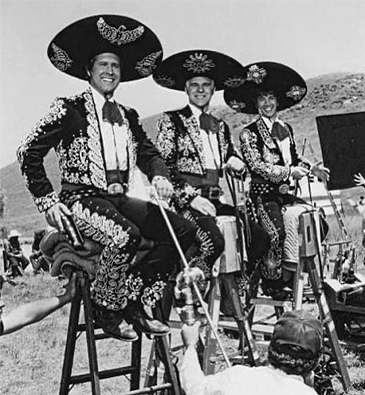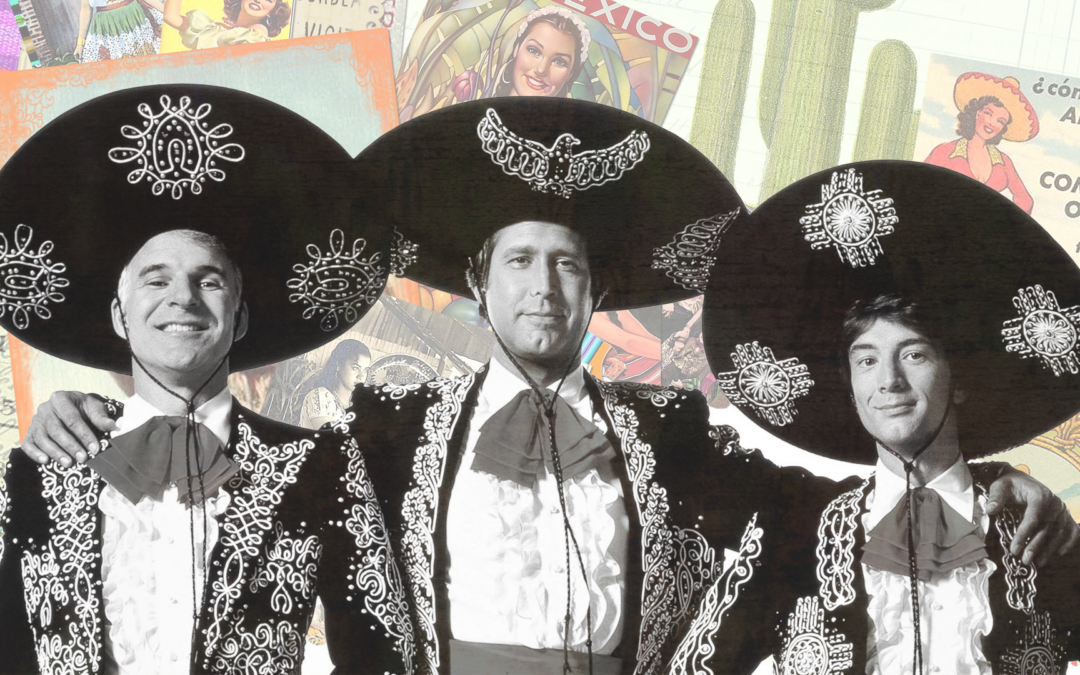John Landis’s 1986 comedy Three Amigos is well-known as a classic slapstick comedy, but it’s also a sophisticated exploration of semiotics, self-reference and cultural critique. Through its use of satire, the film explores themes of identity, cultural appropriation and the power of myth, while also offering a meta-commentary on Hollywood and the Western genre.
Cultural Appropriation and Myth-Making
Three Amigos begins with a satirical critique of Hollywood’s historical tendency to appropriate and misrepresent other cultures. The film’s protagonists, Lucky Day (Steve Martin), Dusty Bottoms (Chevy Chase) and Ned Nederlander (Martin Short), are out-of-work silent film stars who unwittingly become embroiled in a real-life conflict in a small Mexican village. The Amigos, believing they are still on a film set, try to embody the legendary heroes they once played on screen, only to discover that their perceived heroism is a mere construction, not rooted in reality.
This mistaken belief highlights the problematic nature of Western culture commodifying and simplifying other cultures for entertainment. The film underscores how myths, especially those perpetuated by Hollywood, can distort reality which reinforces stereotypes and perpetuates cultural misunderstandings. The villagers’ initial belief in the Amigos as saviors reflects the power of myth to shape perceptions, even when those myths are based on superficial and inaccurate representations.
Identity as Performance
A key theme in Three Amigos is the constructed nature of identity, particularly how identity is influenced by external factors such as myths, stereotypes and societal expectations. The humor often stems from the Amigos’ failed attempts to live up to their own exaggerated reputations. Their performances as legendary heroes are consistently undermined by their ineptitude, revealing the absurdity of their self-imposed roles.
This aligns with the semiotic idea that identity is not fixed but is instead a fluid construct, shaped by signs and symbols within a cultural context. The Amigos’ journey from actors to unwitting heroes mirrors the idea that identity is a performance, one that is constantly being negotiated and redefined based on context and perception.

Self-Reference and Hollywood Critique
Three Amigos is rich in self-referential humor, frequently breaking the fourth wall to comment on its own narrative and the broader conventions of Hollywood filmmaking. This self-awareness is evident in the way the film satirizes Hollywood stereotypes, particularly the genre’s tendency to romanticize and oversimplify cultural narratives.
The film’s exaggerated depictions of the Mexican village and its inhabitants serve as a parody of Hollywood’s reductionist portrayal of “foreign” cultures. The Amigos themselves, far from the stoic, hyper-competent heroes typical of Westerns, are bumbling and clueless, which is a direct subversion of genre conventions. By flipping these tropes on their head, the film critiques the genre’s often uncritical perpetuation of cultural myths.
Meta-Narrative and Genre Subversion
The film also functions as a meta-narrative, where the lines between fiction and reality blur, reflecting the characters’ confusion about their roles. The Amigos’ belief that they are still acting in a film serves as a commentary on the artificiality of Hollywood storytelling. This self-referential loop creates a narrative where the characters’ actions are both a performance and a reality, challenging the audience to consider the constructed nature of all narratives, whether on screen or in life.
Landis uses filmmaking techniques that further this self-referential approach. The exaggerated plot developments and over-the-top special effects are a playful critique of the excesses of Hollywood filmmaking. The film’s climax (where the entire village dresses as the Amigos to confuse the villain El Guapo) is a perfect example of this meta-commentary. This scene underscores the film’s exploration of identity and the power of symbols, as the villagers’ adoption of the Amigos’ costumes blurs the line between the real and the performative.
Conclusion
Through its satirical portrayal of cultural appropriation, identity, myth and stereotypes, the film invites viewers to question the narratives that shape our understanding of the world. Its self-referential elements add a layer of complexity, making it a film that is deeply aware of its role within the broader context of Hollywood filmmaking and popular culture. In doing so, Three Amigos stands as both a celebration and a critique of the very myths and conventions it parodies, offering a rich text for analysis and reflection.


Recent Comments